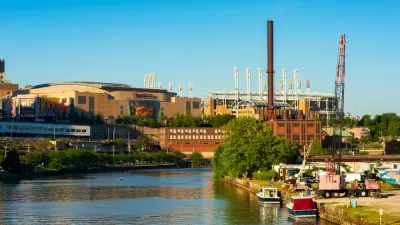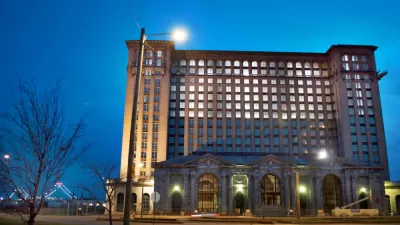Chloe E. Taft explores the transition of Bethlehem, Pa., from Rust Belt company town to gambling mecca.

 If Bruce Springsteen went back to school and pursued his Ph.D. in urban planning, Steel to Slots is probably the dissertation he would write. Absent the exuberance of a rock n' roll soundtrack, Chloe E. Taft, a postdoctoral fellow in American Studies at Yale, has written a sober, intricate account of the transition to the chirps, beeps, and bells of the experience economy from the analog fury of foundries and blast furnaces.
If Bruce Springsteen went back to school and pursued his Ph.D. in urban planning, Steel to Slots is probably the dissertation he would write. Absent the exuberance of a rock n' roll soundtrack, Chloe E. Taft, a postdoctoral fellow in American Studies at Yale, has written a sober, intricate account of the transition to the chirps, beeps, and bells of the experience economy from the analog fury of foundries and blast furnaces.
The city of Bethlehem was founded in 1741 by the Moravians, an "emotional, and almost mystical" Protestant sect that settled in the hills of the Lehigh Valley. One-hundred-fifty years later, their gracious city was dominated the hellscape of 20th century heavy industry. Fueled by Pennsylvania coal, the Bethlehem Steel Corporation, known locally as "the Steel," grew to become the third-largest industrial company in the world, producing the foundational material for everything from skyscrapers to battleships. Through it all, the Steel remained in its small namesake city, making Bethlehem the quintessential company town.
Any number of Springsteen lyrics tell the rest of the story. In the third quarter of 1977 alone, the Steel lost $477 million. It closed plants, laid off workers, and restructured, its famous logo—an image of an H-beam behind the word "Bethlehem"—growing less ubiquitous by the day. Some trace the company's demise to the moment when it lost the bid to supply steel for the World Trade Center, a half-century after it built the Empire State Building. The company closed the Bethlehem plant in 1995, declared bankruptcy in 2001 and folded in 2003. It sold many assets to Luxembourg's ArcelorMittal but left behind one of the largest intact industrial sites in the nation. (By contrast, scarcely a trace of U.S. Steel's plants remain in Pittsburgh.)
Where ore and coke were once turned into sheets and girders, money is now being made hand-by-hand. It's not producing anything tangible, but it is presumably producing profits—for the Las Vegas Sands Corporation. In 2004, Pennsylvania legalized gambling, promising that gambling taxes would go to a Christmas tree of worthy causes. The timing could not have been more perfect for a city that had essentially no idea how to redevelop the 1,500-acre site.
Though newly constructed, Sands' centerpiece casino adopts an industrial aesthetic, with brick walls, exposed pipes and beams, and orange lights that mimic molten ingots. An enormous truss that used to carry trains over the ore yards remains as a bridge to nowhere, holding up a neon Sands logo. While many historic buildings have been demolished, the Steel's dormant blast furnaces still loom over the casino. It is an oddly fitting addition to Sands' collection of ersatz palaces. But, unlike the Palazzo in Las Vegas or the Venetian in Macao, the Sands Bethlehem is a replica of itself.
Taft explores a wide range of scholarly implications and raw emotions that come with Sands' arrival in Bethlehem. She contends that "referencing Bethlehem's industrial past was a way to gain legitimation for its development interests" and wonders whether Sands' corporate interest can coexist with reverence for the city's past. She interviews Bethlehem old-timers who lament the demise of the tangible economy and for whom "Sands' circa-1942 industrial theme fulfills… (a) fantasy – one of stable employment in American manufacturing." Ultimately, Taft sees all sides: "(in) Bethlehem's once-teeming steel plant, act as discursive and material building blocks through which residents narrate and construct fear and desire, disappointment in the past, and hope for the future."
For all of Bethlehem's architectural nostalgia, Taft does not romanticize steel nor does she condemn gambling. Whatever gambling lacks in material productivity, the Steel equaled in environmental degradation and health risks. Taft concludes that both industries, in their times, were enormous forces in global capitalism, operating far beyond the confines of the Lehigh Valley and more focused on shareholder value than on long-term stability for workers. Sands, which Taft calls the "largest real estate developer in the world," now reaps over 80 percent of its profits from its casinos in Macau (the Bethlehem casino accounts for 3 percent), and even the Steel had global operations and capital flows that divorced it from its symbolic home base.
With changes to Bethlehem's economy, so came pressures on its residents. Taft offers a post-Steel ethnography of working-class South Bethlehem, focusing on the Eastern European immigrants who worked at the plant in its heyday and the largely Mexican and Puerto Rican immigrants who worked there during its demise. Having settled in Bethlehem for the Steel, they now hold an uncertain place in the community. Taft contrasts them with Bethlehem's Asian visitors, who make up the majority of the Sands' customers. Intent on gambling, many of them have little interest in the city's heritage or even in other attractions, such as an arts organization, that occupy the Steel site.
Taft's is a high-minded treatment of a decidedly blue-collar topic. Her analysis is not heavy-handed, and her language is accessible if not always engaging. In aiming for a scholarly audience, though, Taft misses an opportunity to explore the essential connection between landscape and industrial location (Pennsylvania being the heart of coal country). And she largely neglects the process of producing and distributing steel. Text and maps refer tantalizingly to sintering, weldment, foundries, drop forges, and blower houses—but she defines little. She either expects readers to know what they are or, worse, treats them as arbitrary elements of a capitalist process that are not inherently exciting or interesting.
Through it's subtitled "Casino Capitalism in the Postindustrial City," Taft focuses on just one industry and one city. Even so, it is a reasonable cautionary tale about the temptations that may cities, from Detroit to Boston to Madrid, are facing. The Sands Corporation is now relatively larger—while employing fewer workers for less pay—than the Steel was at its peak. Even in cities that don't allow casinos, the marriage of corporate ambition with human creativity has led to a scourge of placelessness, from Times Square to L.A. Live to every Dave & Buster’s and Imax theater.
Taft does not necessarily dissuade cities from welcoming casinos, but she does want them to be wary. She approves of strict conditions on licensing, such as Massachusetts' requirement that applicants outline plans for a site's use if the casino closes. Taft advocates for community benefit agreements (CBAs) to ensure that casinos invest in the places they inhabit. Planners therefore must play a part: "planning will be key to…ensuring that long term protections will be part of economic growth." Meanwhile, "casino executives are increasingly asked to think and act like urban planners" as they consider how their projects can fit in with, and appeal to, local communities. Whether they can do so sincerely—and whether there is such thing as "sincere" anymore—is another matter.
When she was conducting fieldwork between 2009 and 2013, Taft could not have known how poignant her timing would be. From Slots to Steel comes out at the very moment when one of the leading candidates for president is on a tear about, among other things, the loss of “American jobs” to overseas industry. That very same candidate is the bane of a Republican establishment, led by, among others, Sheldon Adelson, the 22nd-richest person in the world and CEO of Las Vegas Sands.
The irony is enough to make anyone want to pour a Yuengling, crank up the Boss, and wish for simpler times.
From Steel to Slots: Casino Capitalism in the Postindustrial City
By Chloe E. Taft
Harvard University Press
336 pages
$39.95

Planetizen Federal Action Tracker
A weekly monitor of how Trump’s orders and actions are impacting planners and planning in America.

Maui's Vacation Rental Debate Turns Ugly
Verbal attacks, misinformation campaigns and fistfights plague a high-stakes debate to convert thousands of vacation rentals into long-term housing.

San Francisco Suspends Traffic Calming Amidst Record Deaths
Citing “a challenging fiscal landscape,” the city will cease the program on the heels of 42 traffic deaths, including 24 pedestrians.

Amtrak Rolls Out New Orleans to Alabama “Mardi Gras” Train
The new service will operate morning and evening departures between Mobile and New Orleans.

The Subversive Car-Free Guide to Trump's Great American Road Trip
Car-free ways to access Chicagoland’s best tourist attractions.

San Antonio and Austin are Fusing Into one Massive Megaregion
The region spanning the two central Texas cities is growing fast, posing challenges for local infrastructure and water supplies.
Urban Design for Planners 1: Software Tools
This six-course series explores essential urban design concepts using open source software and equips planners with the tools they need to participate fully in the urban design process.
Planning for Universal Design
Learn the tools for implementing Universal Design in planning regulations.
Heyer Gruel & Associates PA
JM Goldson LLC
Custer County Colorado
City of Camden Redevelopment Agency
City of Astoria
Transportation Research & Education Center (TREC) at Portland State University
Jefferson Parish Government
Camden Redevelopment Agency
City of Claremont




























